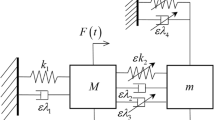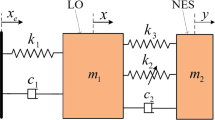Abstract
The present work studies a one-DOF nonlinear unstable primary system, which undergoes harmful limit cycle oscillations, coupled to a network of several parallel nonlinear energy sinks (NESs). As usual, in the framework of NES properties exploration and particularly in the context of dynamic instabilities mitigation, four steady-state response regimes are observed. They are classified into two categories depending on whether the NESs mitigate or not the instability and therefore separating harmless situations from harmful situations. An asymptotic analysis shows that the critical manifold of the system can be reduced to a one-dimensional parametric curve evolving in a N-dimensional space. The shape of the critical manifold and the associated stability properties provide an analytical tool to predict the nature of the possible response regimes mentioned above. In particular, the mitigation limit of the NESs, defined as the value of the chosen bifurcation parameter which separates harmful situations from harmless situations, is predicted. Using more restrictive assumptions, i.e., neglecting the nonlinearity of the primary system and assuming N identical NESs, a literal expression of the mitigation limit is obtained. Using a Van de Pol oscillator as a primary system, theoretical results are compared, for validation purposes, to the numerical integration of the system. The comparison shows a good agreement as long as we remain within the limits of use of the asymptotic approach.













Similar content being viewed by others
Change history
15 November 2018
Remark In the sequel, the equation numbering follows that of the original paper.
Notes
S is hyperbolic if all the eigenvalues of the Jacobian matrices of the differential system (23) have nonzero real parts.
References
Bellet, R., Cochelin, B., Herzog, P., Mattei, P.O.: Experimental study of targeted energy transfer from an acoustic system to a nonlinear membrane absorber. J. Sound Vib. 329, 2768–2791 (2010)
Benoît, E., Callot, J., Diener, F., Diener, M.: Chasse au canard (”duck hunting”). Collect. Math. 32(1–2), 37–119 (1981)
Bergeot, B., Bellizzi, S., Cochelin, B.: Analysis of steady-state response regimes of a helicopter ground resonance model including a non-linear energy sink attachment. Int. J. Non Linear Mech. 78, 72–89 (2016). https://doi.org/10.1016/j.ijnonlinmec.2015.10.006
Bergeot, B., Bellizzi, S., Cochelin, B.: Passive suppression of helicopter ground resonance using nonlinear energy sinks attached on the helicopter blades. J. Sound Vib. 392, 41–55 (2017). https://doi.org/10.1016/j.jsv.2016.12.039
Bergeot, B., Berger, S., Bellizzi, S.: Mode coupling instability mitigation in friction systems by means of nonlinear energy sinks : numerical highlighting and local stability analysis. J. Vib. Control (2017). https://doi.org/10.1177/1077546317707101
Desroches, M., Guckenheimer, J., Krauskopf, B., Kuehn, C., Osinga, H., Wechselberger, M.: Mixed-mode oscillations with multiple time scales. SIAM Rev. 52(2), 211–288 (2012). https://doi.org/10.1137/100791233
Domany, E., Gendelman, O.: Dynamic responses and mitigation of limit cycle oscillations in Van der Pol-Duffing oscillator with nonlinear energy sink. J. Sound Vib. 332(21), 5489–5507 (2013). https://doi.org/10.1016/j.jsv.2013.05.001
Fenichel, N.: Geometric singular perturbation theory for ordinary differential equations. J. Differ. Equ. 98, 53–98 (1979)
Gendelman, O., Vakakis, A., Bergman, L., McFarland, D.: Asymptotic analysis of passive nonlinear suppression of aeroelastic instabilities of a rigid wing in subsonic flow. SIAM J. Appl. Math. 70(5), 1655–1677 (2010). https://doi.org/10.1137/090754819
Gendelman, O.V.: Targeted energy transfer in systems with external and self-excitation. Proc. Instit. Mech. Eng. Part C J. Mech. Eng. Sci. 225(9), 2007–2043 (2011). https://doi.org/10.1177/0954406211413976
Gendelman, O.V., Bar, T.: Bifurcations of self-excitation regimes in a Van der Pol oscillator with a nonlinear energy sink. Physica D 239(3–4), 220–229 (2010). https://doi.org/10.1016/j.physd.2009.10.020
Gourdon, E., Alexander, N.A., Taylor, C.A., Lamarque, C.H., Pernot, S.: Nonlinear energy pumping under transient forcing with strongly nonlinear coupling: Theoretical and experimental results. J. Sound Vib. 300(3–5), 522–551 (2007). https://doi.org/10.1016/j.jsv.2006.06.074
Grasman, J.: Asymptotic Methods for Relaxation Oscillations and Applications. Applied Mathematical Sciences, vol. 63. Springer, Berlin (1987)
Jones, C.: Geometric singular perturbation theory. In: Johnson, R. (ed.) Dynamical Systems. Lecture Notes in Mathematics, vol. 1609, pp. 44–118. Springer, Berlin (1995). https://doi.org/10.1007/BFb0095239
Kerschen, G., McFarland, D.M., Kowtko, J.J., Lee, Y.S., Bergman, L.A., Vakakis, A.F.: Experimental demonstration of transient resonance capture in a system of two coupled oscillators with essential stiffness nonlinearity. J. Sound Vib. 299(4–5), 822–838 (2007). https://doi.org/10.1016/j.jsv.2006.07.029
Kuehn, C.: Multiple Time Scale Dynamics, Applied Mathematical Sciences, vol. 191, 1st edn. Springer, Berlin (2015)
Lee, Y.S., Vakakis, A.F., Bergman, L.A., McFarland, D.M., Kerschen, G.: Suppression aeroelastic instability using broadband passive targeted energy transfers, part 1: theory. AIAA J. 45(3), 693–711 (2007). https://doi.org/10.2514/1.24062
Lee, Y.S., Vakakis, A.F., Bergman, L.A., McFarland, D.M., Kerschen, G.: Suppression aeroelastic instability using broadband passive targeted energy transfers, part 2: experiments. AIAA J. 45(3), 2391–2400 (2007). https://doi.org/10.2514/1.24062
Li, T., Gourc, E., Seguy, S., Berlioz, A.: Dynamics of two vibro-impact nonlinear energy sinks in parallel under periodic and transient excitations. Int. J. Non Linear Mech. 90, 100–110 (2017). https://doi.org/10.1016/j.ijnonlinmec.2017.01.010
Luongo, A., Zulli, D.: Aeroelastic instability analysis of nes-controlled systems via a mixed multiple scale/harmonic balance method. J. Vib. Control (2013). https://doi.org/10.1177/1077546313480542
Luongo, A., Zulli, D.: Nonlinear energy sink to control elastic strings: the internal resonance case. Nonlinear Dyn. 81(1), 425–435 (2015). https://doi.org/10.1007/s11071-015-2002-8
Manevitch, L.: Complex representation of dynamics of coupled nonlinear oscillators. In: Uvarova, L., Arinstein, A., Latyshev, A. (eds.) Mathematical Models of Non-Linear Excitations, Transfer, Dynamics, and Control in Condensed Systems and Other Media, pp. 269–300. Springer, Berlin (1999). https://doi.org/10.1007/978-1-4615-4799-0_24
Nucera, F., Vakakis, A.F., McFarland, D.M., Bergman, L.A., Kerschen, G.: Targeted energy transfers in vibro-impact oscillators for seismic mitigation. Nonlinear Dyn. 50(3), 651–677 (2007). https://doi.org/10.1007/s11071-006-9189-7
Starosvetsky, Y., Gendelman, O.V.: Strongly modulated response in forced 2dof oscillatory system with essential mass and potential asymmetry. Physica D 237(13), 1719–1733 (2008). https://doi.org/10.1016/j.physd.2008.01.019
Taghipour, J., Dardel, M.: Steady state dynamics and robustness of a harmonically excited essentially nonlinear oscillator coupled with a two-DOF nonlinear energy sink. Mech. Syst. Signal Process. 62–63, 164–182 (2015). https://doi.org/10.1016/j.ymssp.2015.03.018
Ture Savadkoohi, A., Vaurigaud, B., Lamarque, C.H., Pernot, S.: Targeted energy transfer with parallel nonlinear energy sinks, part II: Theory and experiments. Nonlinear Dyn. 67(1), 37–46 (2012). https://doi.org/10.1007/s11071-011-9955-z
Vakakis, A.F., Gendelman, O.V., Bergman, L.A., McFarland, D.M., Kerschen, G., Lee, Y.S.: Nonlinear Targeted Energy Transfer in Mechanical and Structural Systems. Springer, Berlin (2008)
Vaurigaud, B., Ture Savadkoohi, A., Lamarque, C.H.: Targeted energy transfer with parallel nonlinear energy sinks. Part I: design theory and numerical results. Nonlinear Dyn. 66(4), 763–780 (2011). https://doi.org/10.1007/s11071-011-9949-x
Author information
Authors and Affiliations
Corresponding author
Ethics declarations
Conflict of interest
The authors declare that they have no conflict of interest concerning the publication of this manuscript.
Appendices
A Projection of the super-slow dynamics on the critical manifold
Equation (32) is developed into the following form
where functions \(\mathscr {F}\), \(\mathscr {G}_n\) and \(\mathscr {H}_n\) are deduced from functions f and \(g_n\) in systems of Eqs. (10) and (11) as
From system of Eqs. (62), we obtain the real form of the slow and super-slow subsystems (13) and (14) as
and
respectively.
We assume that fixed points of (62) exist only at the super-slow timescale and they are therefore fixed points of (65). Of course, the CM can be also obtained solving Eqs. (65b) and (65c). Then, substituting system of Eq. (19) with \(n=1\) (any \(n\in [1,\,N]\) can be chosen) into (65a) , we obtain
which can be reduced to
where \(f_{r_1}=2 \sqrt{H_1\left( r_1 \right) } \mathscr {F}\). In reality, \(f_{r_1}\left( r_1,\ldots ,r_N\right) \) is a single-valued function because all variables \(r_n\) (with \(n\in [1,\,N]\)) are linked to each other through Eq. (22) (any \(n\in [1,\,N]\) can be chosen as master component, we choose \(r_1\)).
B Proof of Result 4.1
Because N identical NESs are assumed, the function \(H_n(x)\) is now denoted H(x). Considering also a linear primary system (\(\tilde{f}_{\mathrm{NL}} = 0\)), system of Eq. (37) becomes
Equation (68b) is a third-order polynomial equation with respect to \(r_n^2\) having the three following roots as a function of \(r_1\)
The functions \(f_2(r_1^2)>f_3(r_1^2)\). If \(\mu >a/\sqrt{3}\), \(r_n^2 = f_1(r_1^2)=r_1^2\) is the only real solution.
Using system of Eqs. (69), (68a) is written as follows
where \(g_n(r_1^2)\) can be, for each term of the sum, \(f_1(r_1^2)\), \(f_2(r_1^2)\) or \(f_3(r_1^2)\).
If \(\forall n \in [2,N], g_n(r_1^2)=f_1(r_1^2)=r_1^2\), Eq. (70) becomes
Ignoring the trivial solution, Eq. (71) is reduced to a second-order polynomial equation with respect to \(r_1^2\) with the following solutions
and
which are real if \(\rho <\frac{a^2 N}{\mu }\). In this case, \(r_{1,1}^{*2}<r_{1,2}^{*2}\).
Considering first the case \(\mu >a/\sqrt{3}\), \(r_n^2 = f_1(r_1^2)\) is the only real solution, \( r_{1,1}^{*2}\) and \( r_{1,2}^{*2}\) are therefore the only solutions given Eq. (48) with \(w=r_{1,2}^*\).
We consider now the case for which \(\mu <a/\sqrt{3}\). Solving \(f_1(r_1^2)=f_2(r_1^2)\) (to find the intersection between the functions \(f_1\) and \(f_2\)) and \(\mathrm{d}f_2(x)/\mathrm{d}x=0\) (to find the maximum of \(f_2\)) gives the same value of \(r_1^2\) as
which corresponds also to one of the solutions of \(H'\left( r_1\right) =0\) (see Eq. (25b)), i.e., \(r_{1}^{\star }=r^m\) (where \(r^m\) is \(r_n^m\) in the case of identical NESs).
The difference between \(r_{1,2}^{*2}\) and \(r_{1}^{\star 2}\) is
which is a real positive number until \(\rho =\frac{a^2 N}{\mu }\). Therefore, for \(r_1^2>r_{1}^{\star 2}\), \(f_1(r_1^2)>f_2(r_1^2)\) and the right-hand side of Eq. (70) is bounded as follows
Let \(\mathscr {R}_l\), \(\mathscr {R}_c\) and \(\mathscr {R}_r\) be the sets of fixed points \(\mathbf r^*\), the solutions of \(H(r_1)=R_l\), \(H(r_1)=R_c\) and \(H(r_1)=R_r\), respectively. Consequently, because for \(r_1^2>r_{1}^{\star 2}\), \(H(r_1)\) in an increasing function and because of Eq. (76), the following inequalities hold
with
giving also Eq. (48) with \(w=r_{1,2}^*\).
To finish the proof, one must show that \(\mathbf{r^*}= \left[ r_1=w,\ldots ,r_N=w \right] \) is an unstable fixed point on a stable part of S. To this end, the derivative with respect to \(r_1\) of the function
defined by Eq. (39), is computed as
By definition, the term \(\rho H(r_1)-\mu N \, r_1^2=0\) if \(r_1=r_{1,2}^{*2}\) (see Eq. (71)). Moreover, because \(r_{1,2}^{*2}>r_{1}^{\star 2}=r^m\)
Therefore, the sign of Eq. (80) is given by the sign of \(\rho H'(r_1)-2 \mu N \, r_1\). One can be shown that \(\rho \frac{dH_1(r_1)}{\mathrm{d}r_1}-2 \mu N \, r_1\) is a real-valued function if \(r_1>\kappa \) with
and that \(r_{1,2}^{*}>\kappa \) until \(\rho =\frac{a^2 N}{\mu }\). Consequently, using Result 3.2 (\(\frac{\mathrm{d}f}{\mathrm{d} r_1} ({r_1})>0\)), \(r_{1,2}^{*}\) is an unstable fixed point and Result 4.1 is demonstrated.
Rights and permissions
About this article
Cite this article
Bergeot, B., Bellizzi, S. Asymptotic analysis of passive mitigation of dynamic instability using a nonlinear energy sink network. Nonlinear Dyn 94, 1501–1522 (2018). https://doi.org/10.1007/s11071-018-4438-0
Received:
Accepted:
Published:
Issue Date:
DOI: https://doi.org/10.1007/s11071-018-4438-0




